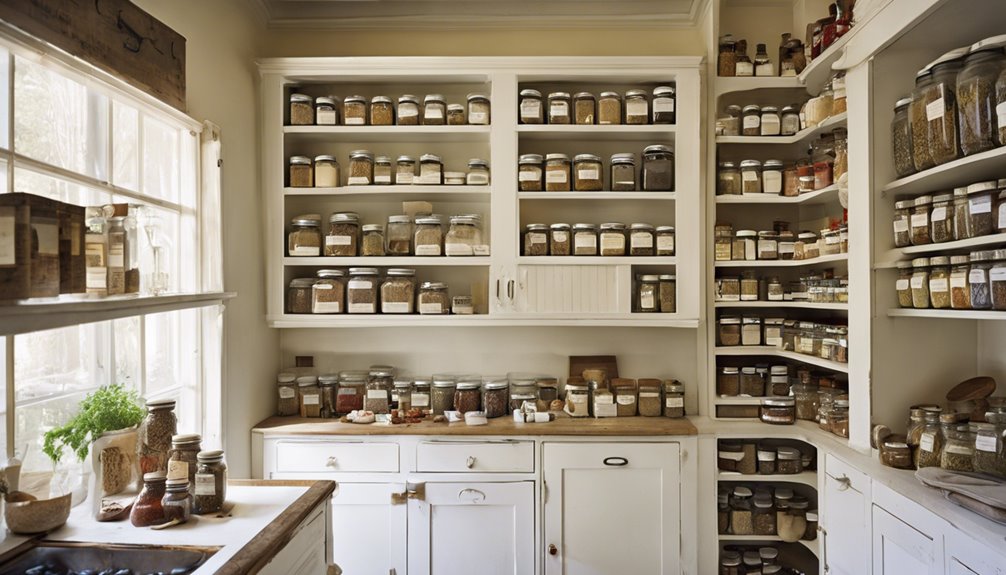You should store food at least 6 inches off the floor to prevent contamination and comply with health regulations. This height helps avoid pest issues and reduces the risk of spoilage. For ideal organization, keep dry goods about 18 to 24 inches high, while heavier items should be stored lower to minimize injury risk. Always use airtight containers to maintain quality and separate raw foods from ready-to-eat items to prevent cross-contamination. Guaranteeing proper storage height also promotes a safer kitchen environment. Learn more about effective storage techniques and best practices to guarantee your kitchen remains efficient and compliant.
Importance of Proper Food Storage
Proper food storage is essential not just for maintaining freshness but also for ensuring safety. When you implement effective storage techniques, you minimize the risk of contamination and spoilage. Understanding food safety principles is important; for instance, keeping raw meats separate from ready-to-eat foods prevents cross-contamination. Utilizing airtight containers helps preserve quality and deter pests.
Temperature control is critical, so always store perishables in the refrigerator or freezer as needed. Regularly check expiration dates to discard items that could pose health risks. By being proactive in your food storage practices, you're not only extending the shelf life of your ingredients but also promoting a healthier environment. Remember, proper food storage isn't just about convenience; it's about safeguarding your health and well-being.
Recommended Height Guidelines
When it comes to food storage, adhering to recommended height guidelines can greatly impact both safety and accessibility. Ideally, you should store food at least 6 inches off the floor to prevent contamination from spills and pests. For shelf height, aim for a distance of 12-18 inches between shelves to guarantee proper air circulation. This spacing helps maintain food safety by minimizing moisture buildup, which can lead to spoilage or mold growth. Additionally, frequently used items should be placed at eye level for easy access, while heavier items should be stored lower to avoid injuries. By following these guidelines, you'll not only enhance food safety but also create a more organized and functional storage space that respects your freedom to cook and create.
Factors Affecting Storage Height
Several factors influence the ideal height for food storage, ensuring both safety and efficiency. One key factor is the type of storage materials used; some materials may be more suitable for specific environments, affecting how high you can safely store items. For example, metal racks might allow for greater height than wooden shelves, which can warp over time. Additionally, height standards set by health codes or industry regulations often dictate how far above the floor food must be stored to prevent contamination. You should also consider accessibility; items stored too high can pose risks when retrieving them. Balancing these factors will help you determine the most effective storage height for your needs while maintaining a safe environment.
Storage for Dry Goods
When storing dry goods, it's essential to take into account the ideal height for accessibility and organization. Placing items at the right height not only maximizes space but also aids in pest prevention strategies. By following these guidelines, you'll guarantee your dry goods remain fresh and safe.
Ideal Height Recommendations
While many factors influence the ideal height for storing dry goods, a general guideline suggests that shelves should be positioned between 18 to 24 inches from the floor. This height allows for easy access while ensuring that your items remain organized and secure. Utilizing height measurement tools can help you achieve this best setup.
Here's a quick reference table for ideal storage solutions:
| Dry Goods Type | Recommended Height | Notes |
|---|---|---|
| Canned Goods | 18-24 inches | Easy reach for all users |
| Baking Supplies | 24 inches | Avoid moisture exposure |
| Grains and Pasta | 18-24 inches | Store in airtight containers |
| Snacks and Cereals | 18 inches | Use clear bins for visibility |
Following these guidelines will enhance your storage efficiency.
Pest Prevention Strategies
To keep your dry goods safe from pests, implementing effective storage strategies is essential. Start by using airtight containers that prevent access to insects and rodents. Confirm these containers are made of durable materials that can withstand wear. Storing food off the floor, ideally at least six inches high, enhances pest control by minimizing contact with potential infestations. Regularly inspect your pantry for signs of pests and rotate your stock to use older items first, promoting food safety. Clean spills immediately and maintain a tidy storage area, as crumbs and residues attract pests. Remember, proactive measures are key; by staying vigilant, you can enjoy your food without the worry of unwanted guests.
Refrigerated Food Considerations
When storing refrigerated foods, maintaining an ideal temperature range between 32°F and 40°F is essential for safety and freshness. You'll also want to be mindful of cross-contamination; keeping raw meats separate from ready-to-eat items can prevent foodborne illnesses. Understanding these key considerations helps guarantee the quality and safety of your refrigerated food.
Ideal Temperature Range
Making certain that refrigerated food is stored at the ideal temperature range is essential for maintaining its freshness and safety. The best range for refrigeration is between 32°F and 40°F (0°C to 4°C). Keeping your food within this range helps prevent harmful bacteria from growing, making sure food safety. It's important to regularly check your refrigerator's temperature settings and use a thermometer to confirm accuracy. If temperatures rise above 40°F for an extended period, perishable items may spoil, posing health risks. Always store raw meats on the bottom shelf to avoid drips onto other foods, and make sure the door seals tightly. By adhering to these guidelines, you can enjoy your refrigerated items while minimizing health hazards.
Cross-Contamination Prevention
While you might think that keeping food at the right temperature is enough to prevent foodborne illnesses, preventing cross-contamination is equally important in refrigeration. To minimize cross-contamination risks, use effective food storage techniques. Always store raw meats on the bottom shelves to avoid drips onto other foods, and separate ready-to-eat items from raw products. Make sure to use airtight containers to limit exposure and potential contamination. Additionally, regularly check that your refrigerator maintains an appropriate temperature to inhibit bacteria growth. It's vital to label and date food items, ensuring you use them within safe timeframes. By implementing these practices, you'll safeguard your food, your health, and enjoy the freedom that comes with safe food handling.
Storing Frozen Items Safely
To keep frozen items safe and maintain their quality, it's important to store them at the right temperature. Proper frozen food storage prevents spoilage and guarantees your food remains fresh. Follow these guidelines for ideal storage:
- Temperature: Keep your freezer at 0°F (-18°C) or lower for safe storage.
- Organization: Store items in airtight containers to prevent freezer burn and maintain flavor.
- Safe Thawing: Always thaw frozen food in the refrigerator, cold water, or the microwave—never at room temperature.
Preventing Pest Infestation
After managing your frozen items, it is crucial to contemplate how to prevent pest infestation in your food storage areas. Start with pest identification; knowing the common pests, like rodents and insects, helps you take action before they invade. Keep your storage areas clean and organized. Regularly inspect for signs of pests, such as droppings or damaged packaging. Seal any cracks or holes in walls and floors to block entry points. Utilize airtight containers for food storage to deter pests. Implement effective pest control measures, like traps or natural repellents, as needed. By being proactive and vigilant, you can maintain a pest-free environment that supports your freedom to enjoy safe, fresh food.
Best Practices for Home Kitchens
Creating an efficient home kitchen requires careful attention to organization and hygiene, as these factors considerably impact food safety and preparation. To enhance your kitchen organization and guarantee food safety, consider these best practices:
- Store food at least 6 inches off the floor: This helps prevent contamination and pest issues.
- Use clear containers: Labeling and using transparent storage makes it easier to find items and monitor expiration dates.
- Separate raw and cooked foods: Keep raw meats on lower shelves to avoid cross-contamination with ready-to-eat items.
Commercial Kitchen Regulations
While maneuvering through the complexities of running a commercial kitchen, understanding the regulations that govern food storage height is vital for guaranteeing health and safety compliance. The FDA recommends storing food at least six inches off the floor. This height helps prevent contamination and facilitates effective kitchen inspections. It's important to adhere to these guidelines, as non-compliance can lead to serious repercussions, including fines and potential shutdowns. Regularly reviewing your storage practices will guarantee you maintain storage compliance and keep your kitchen running smoothly. Remember, following these regulations not only protects your food and staff but also promotes a safer environment for your customers. Stay informed about local laws and adapt your storage solutions accordingly to meet these vital standards.
Tips for Organizing Storage Areas
Maintaining compliance with food storage regulations is only part of the equation for a well-functioning kitchen. Organizing your storage areas effectively can enhance efficiency and safety. Here are some tips to take into account:
- Use Creative Containers: Choose clear, stackable bins that allow easy identification of contents while maximizing space.
- Implement Vertical Storage: Utilize shelves and racks to keep items off the floor and accessible. This not only optimizes space but also keeps food safe from contamination.
- Label Everything: Clearly marking your containers and shelves helps staff quickly locate ingredients, reducing prep time and minimizing errors.
Frequently Asked Questions
What Types of Food Require Specific Storage Heights?
Certain types of food require specific storage heights to maintain safety and quality. Canned goods should be stored on shelves at least six inches off the floor to prevent contamination from moisture and pests. Frozen items, on the other hand, can be stored in freezers, but it's best to keep them elevated to avoid spills or ice accumulation. Following these guidelines guarantees your food remains safe and ready for use whenever you need it.
Can I Store Food Directly on the Floor?
Floor storage for food is fraught with flaws. You shouldn't store food directly on the floor due to food safety concerns. Contaminants, moisture, and pests can jeopardize your food's integrity. Instead, elevate your items at least six inches above the floor to guarantee proper ventilation and minimize risks. Prioritizing cleanliness and safety not only protects your food but also grants you peace of mind. So, keep your culinary creations off the ground!
How Do I Measure the Height of My Storage?
To measure the height of your storage, you can use simple measuring techniques. Grab a tape measure or a ruler and position it vertically from the floor to the desired shelving level. Mark the height with a pencil for clarity. Additionally, consider using storage tools like stacking bins or shelves with adjustable heights. This'll help you optimize your space while ensuring you meet safety standards for food storage. Make it efficient, and enjoy the freedom of organized storage!
Are There Exceptions to Height Guidelines for Certain Foods?
Yes, there are exceptions to height regulations for certain foods, especially in food safety. For example, perishable items like dairy or meats might require specific storage heights to maintain ideal temperatures. However, dry goods can sometimes be stored closer to the floor if they're in sealed containers. Always prioritize safety and compliance, but know you have some flexibility based on the type of food and its storage needs.
What Are the Consequences of Improper Food Storage Height?
Improper food storage height can lead to serious consequences regarding food safety. When food isn't stored at the right height, it increases contamination risks from dirt, pests, and moisture. This can compromise the quality of your food and pose health hazards, potentially leading to foodborne illnesses. To keep your meals safe and enjoyable, always pay attention to storage guidelines and guarantee your food is elevated properly above the floor.




